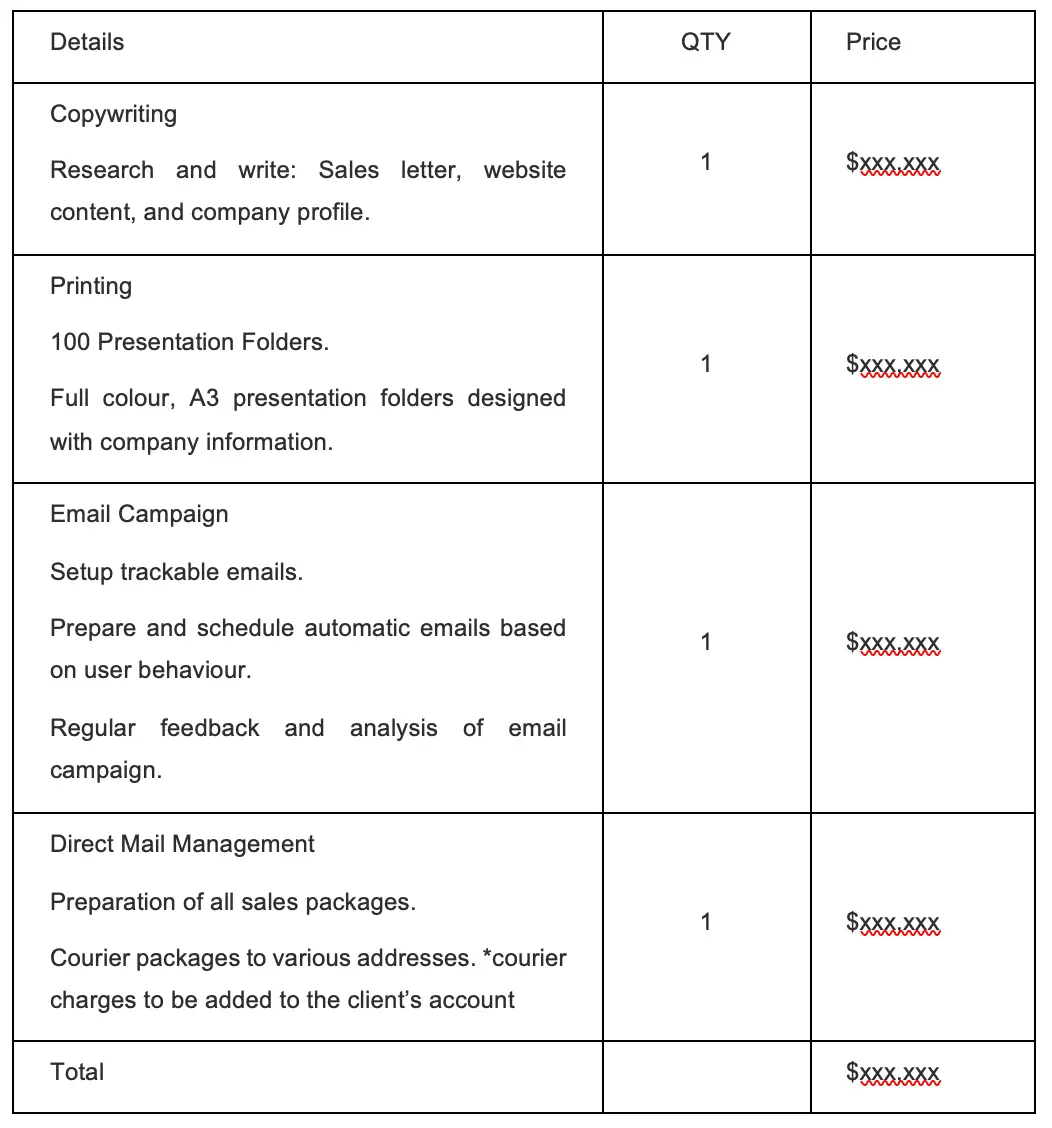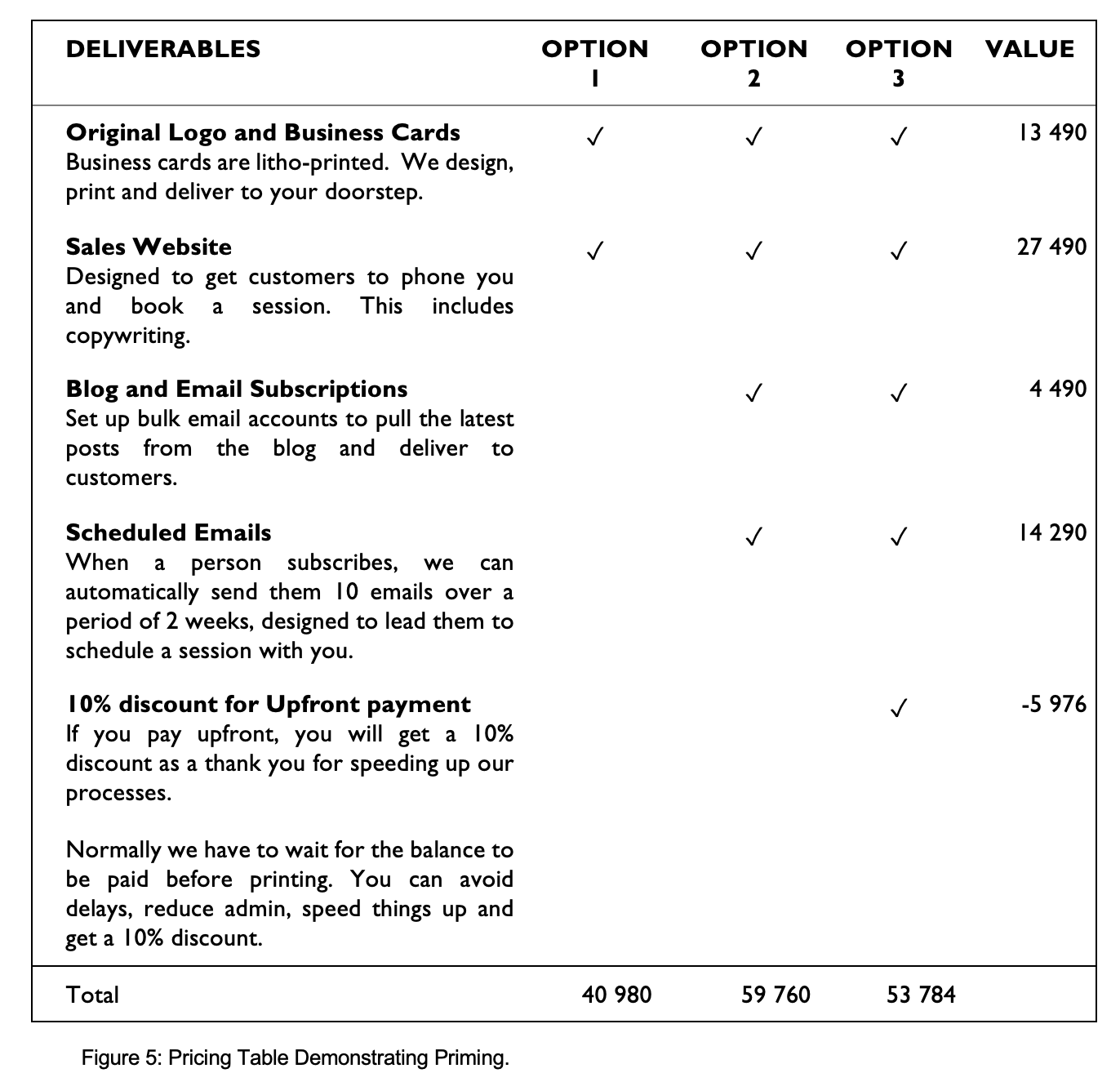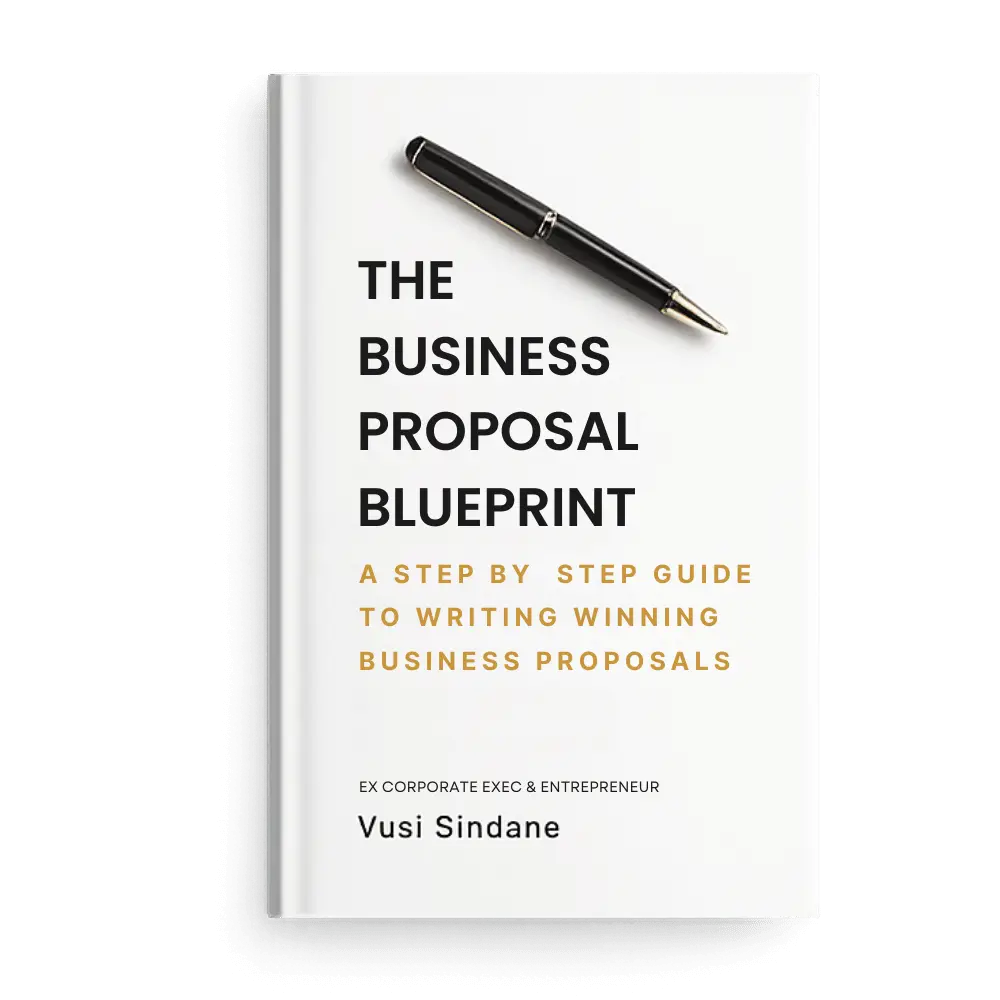
Start Here.
The audio below is 25min long. Please take notes and avoid distractions for maximum impact.
Follow along
I am both excited and grateful that you took your valuable time to listen to this audio. Before we start, please bear in mind that this is Chapter 7 of The Business Proposal Blueprint, a book I published in 2015. My goal is to help you understand the psychology of pricing so that you can get the best value for your goods and reduce friction when your customers think about buying your products.
Before starting, I have some important housekeeping rules.
Learning does not happen when we acquire new information; instead, it happens when we try something new and compare expectations with results. With that in mind, you would have done yourself a great disservice if you read this book and thereafter do nothing. Rather, consider this audio as a guide. Read, try the things I recommend, and then make up your own mind about what works and what does not work.
Unfortunately, this is not a shortcut. You still have to travel the winding and meandering road to mastery. The only difference is that, unlike some of us who learned by trial and error, you can avoid silly mistakes. As a result, you can achieve a similar impact faster.
Okay, enough with the housekeeping. Let’s dive into the main course.
Chapter 7: The Psychology of Pricing
I have a few questions…
- Why do people pay for a first-class plane ticket when the plane will get there at the same time as the people in economy class?
- Why do some people work the whole day in the scorching sun, doing dangerous work for next to nothing compared to executives (who sit in air-conditioned offices and quite literally do nothing but talk)?
- How can Rolls-Royce charge 10 times more for a car that does more or less the same thing as what a VW Golf does?
- How can it be that some restaurants charge a fortune for a gourmet meal, which is nothing but a small piece of meat on a gigantic plate, while fast-food restaurants charge almost nothing for a lot of food?
These are all clues that there’s a lot more going on behind how and why prices are set.
Therefore, in this chapter, we will discuss the theory of pricing according to economists. We will then discuss the psychology of pricing in relation to human behaviour. You will also discover some interesting strategies for finding the right price and justifying it so that your readers commit to putting money into your bank account.
What is Price?
“Misconceptions of the role of prices are common. Many people see prices as simply obstacles to getting the things they want. Those who would like to live in a beachfront home, for example, may abandon such plans when they discover how extremely expensive beachfront property can be. But high prices are not the reason we cannot all live on the beachfront. The inherent reality is that there are not nearly enough beachfront homes to go around and prices simply convey that underlying reality.” – Dr. Thomas Sowell
That’s a quote from a book called Basic Economics by a world renowned economist and thinker, Thomas Sowell. He dedicated an entire chapter in his book to discuss the nature of prices and what they actually mean. For Sowell, price is a signal, it is a communications device. It communicates to the market what goods are available and the value attached to acquiring them. I will come back to this later.
Let’s consider the idea that price is a communications tool. Consider the price-gap between a Golf and a Rolls-Royce. The Rolls-Royce costs almost 10 times the price of a Golf. Hence the message we get (from the price alone) is that a Rolls-Royce is a better car.
Prices also have the power to create a psychological dialogue in one’s mind. For example, as with a Beach House or a Rolls-Royce, prices create scarcity and anticipation for the amount of value you will get.
This is important: I’ll write it again in a slightly different way:
You should use prices to create anticipation and communicate the amount of value you will deliver to your customer.
DIFFERENTIATION & PRICING
The way to run a profitable business is to provide value in a way that nobody else can. If you can do this, you will be able to charge significantly more for the differentiated value compared to your competitors.
The trouble with differentiation, of course, is that you cannot make everyone happy. Therefore, you must accept that some people will not appreciate the differentiated value which you have created, and therefore, they will see no point in paying extra for something they can get somewhere else. Do not be deterred by such people, they are simply not your customers. After all, this is why we don’t see Rolls-Royce ads on national TV.
If we use the example of selling bread, some people may be totally happy with having sliced bread at a slightly higher price, while other people will prefer to slice it themselves. Be sensitive to how people respond to your differentiation, and don’t be afraid to charge a premium, especially if the additional value cannot be found anywhere else.
THE SECRET TO PRESENTING PRICING
I once saw an estimate (or quote) for $10,000, and there was literally one item on the quote that said, “Services.” The immediate questions from the finance people were, “What services are these? And why do they cost so much?” The sheer laziness cost the vendor 6 weeks of unnecessary back-and-forth before they got any business. They were lucky we could not find a replacement in the interim. You do not want to leave your proposals and pricing to such chance.
The pricing in your proposal should summarise what you’ve been communicating in the entire document thus far. If your solution has 5 parts to it, and you explained those parts in the proposal, then your pricing should also have 5 parts to it, each matching your proposed solution.
For example, suppose you run a marketing and graphic design agency and in your proposal, you offered 5 products: copywriting, printing, email marketing and direct mail. Likewise, in your pricing table, you should have five lines, each providing a monetary value to the items you proposed.

Of course, this is common sense, but you will be amazed at how often a bundle of services are never mentioned in the final quote. This mistake costs money.
PRIMING
In the fourth chapter, we spoke briefly about the story of a suit salesman who starts at top-end prices and gradually goes down. This is a concept called priming. Just to demonstrate how priming works, do this quick exercise:
Think about taking a bath. Imagine you are sinking into a nice warm tub after a long day. Got the image in your mind? Good, now think about a four-letter word that starts with the letter S and ends with P. If you can’t think of it, grab a pen and paper and write S, skip two spaces, and then write P and then try to fill in the missing two spaces.
If you’re like most people, you will probably get the word SOAP. If I had said to you, “Think about a nice hot meal in winter,” — in other words, if I had primed you differently — then you would probably have said SOUP. This little experiment and other useful insights about the mind can be found in Daniel Kahneman’s book titled “Thinking, Fast and Slow.”
The idea behind priming is that little pieces of information can be introduced to bend the mind towards thinking in a particular way. Now that you’re acquainted with this concept, think about all the situations in real life where priming is used to induce a particular behaviour from people.
To get the ball rolling, I’ll give you three examples:
Example 1.
This was actually done as an experiment: A group of volunteers were put in a room and were shown words and objects associated with the elderly, i.e. wrinkles, elderly care homes, and bowling, etc.
It was observed that when the volunteers walked out of the room, they walked slower than normal. It was concluded that their change in behaviour was because of the priming videos they had seen.
Example 2.
Playing music such as “We are the world by Michael Jackson” or music that has to do with reaching out and helping others was observed to influence people to be more helpful towards one another.
In fact, right after democracy was introduced in South Africa, there was a popular song called, “Peace in our land” which played on almost every TV and radio station. It was a political campaign to unite South Africans after decades of bloodshed. The technique of priming (through music, in this case) was effectively used as one of the tools to encourage togetherness during a time when South Africa was standing on a knife-edge.
Priming, as you can see, is a powerful tool. I think it is even more powerful because it works when people are not aware of it.
Example 3.
There was an experiment where a group of women looking for employment were asked to come in for interviews (one by one). They made the women wait for almost an hour until the receptionist cancelled the interviews.
On their way out, the research team had placed another woman outside, carrying a heap of books, trying to open her car door. As she struggled, the books fell and were scattered on the ground. It was observed that the interviewees just ignored the struggling woman (maybe because they were upset about the interview).
Then the experiment was modified to test for priming. While the women were sitting in the reception, waiting for the interview, they brought in a hunk — broad shoulders, iron jaw, square head and smelling like a billion dollars. The man was instructed to chat up the women while they waited. An hour later, the receptionist told them that the interviews were cancelled. As the women walked out of the building, they met a woman with a heap of books, struggling to open her car and thus dropping the books. This time, however, the interviewees were more than happy to help her.
So, it was concluded that a (sexy) male presence primes women to behave more helpfully towards others. I swear I didn’t make this up…
–
Now that you know what priming is all about, can you imagine other scenarios where priming is at play? Now that you think about it, you might find that priming is everywhere. It consists of all the little things that people do to get compliance without the other person knowing.
Let’s turn our attention back to writing proposals.
My favourite way to prime customers is to present three prices — usually in table format. The first column lists my offerings as mentioned. Then the second, third and fourth columns offer options. Option one is usually the most expensive, descending down to the least expensive option. The first option offers the customer more than they asked for, but it’s also much higher than the customer’s budget. This is priming. The second option offers what they were looking for, but priced slightly higher than they expected. The last option offers far less than the customer asked for, hence, it is a decoy.

Giving a customer one price is adversarial — it’s a take it or leave it attitude. Unless this is the story you want to tell, it is best to avoid it. However, giving the customer options makes they feel like they have made a choice. Presenting the options from highest to lowest introduces priming and encourages the customer to spend more than they ordinarily would have.
PRICE TRANSLATION
Once you’ve presented the price, there’s one more thing you can do, which is not optional. In fact, it’s vital! If a client has ever told you that you’re too expensive, then this is why:
Ask yourself the question, why don’t customers of supercars say that those cars are expensive? Why don’t patrons of 7-star hotels say that the accommodation is too expensive? Why don’t people who buy high-end cameras and lenses say that they are overpriced? Is it because they have the money to spend?
No, it has very little to do with having a lot of money. In most cases, people spend their last cent to satisfy a craving or get relief from a problem they have. It’s more to do with translating the benefits (in the proposal) into the price.
Here’s what I mean:
If you have a person who ate 2 hours ago, then the value of a plate of food (for them) will not be anywhere near a person who has not had a meal for two days. In fact, there was a time when I hit rock bottom, and I went for almost two days without a meal. I donated blood just to get biscuits and juice. The point is: A hungry person will do almost anything to get a plate of food, even risk their lives.
As you can see, the value of something can change depending on the situation. This opens us to a big loophole in how we interpret the relationship between value, price and products. Price should reflect the value of the product or service, not what you want to put into your pocket, and definitely not what it costs you to make or provide the service. Here are some techniques for translating price to value:
– The Art of Contingency Pricing
Contingency pricing is when you tell someone that they must pay you contingent on something happening.
Here’s a real-life example: A friend of mine walked into our offices and said, “How much are you spending on all your cell phone contracts and telephone lines?” Before I could say anything, he said, “If I can save you 50%, can we share the savings?” This means if my telephone bill was R5,000, and he could cut it down to R2,500, then I would pay him a portion of that savings.
This is contingency pricing, and it presents a no-brainer! There was no risk for me, but there was a potential benefit. So, we agreed, and he came back to help cut down our telephone bill. Use this method if you are certain you can deliver value at a certain price, and if that value will save your customer a certain amount of money.
We used the contingency billing model for a project in the Free State. Our client was a government department that was outsourcing the procurement of school stationery to other companies. Of course, those companies were adding a margin to all the prices, and we saw an opportunity to cut them out.
We pitched to the client that they could save hundreds of millions if they learned to buy directly from manufacturers. On the face of it, this sounds easy. However, buying at scale involves lots of intricate logistics, distribution and timing. As a result, we positioned ourselves as the perfect partner to teach them these skills. This is where contingency billing came in. We estimated how much they could save from buying directly, and offered that we share in the savings over two years as we helped them insource the procurement. The result was a R100 million project.
– Value-Based Pricing
In some instances, you cannot offer contingency pricing because you want the customer to pay upfront for a product or service. In this case, you have to translate the price into value. Here’s how to do it.
In 2016, I had a dedicated Uber driver who transported me from home to the office and gym every day. I paid him a fixed amount of R5000 per month and sometimes more. You could argue that I was better off buying a small car.
However, this was my thinking:
- If I bought a car, firstly, the instalment, insurance, fuel, brake pads, tyres and fixing dents and scratches would cost a lot more per month than what I was paying the Uber driver.
- This arrangement also meant my credit score would not be bogged down by a big purchase.
- In case of urgent meetings, Uber was always 5 minutes away.
- I could also work in transit, especially in the mornings when there was traffic.
All of the above justified the price for me. Granted, some of the points are intangible, which means there is no financial value. However, as a whole, they justified spending R5000 on an Uber driver instead of buying a car.
Remember this: A transaction only happens if you get more than you give. In the example above, at least in my view, I was getting more than the price I was paying. Most of the value was intangible — time savings, convenience and productivity — all of which mattered to me more than the money I was willing to pay. Similarly, the driver was happy because he had a guaranteed fixed income for one hour’s worth of work per day.
So, when writing your proposal, you also have to translate the value for your customer. In doing so, think about how the value you are giving can be understood as more than the money they will be paying you.
It’s no good saying, “I make logos” or “I sell luxury watches.” You have to make a list of arguments that translate the price you are charging into the value your customer will gain.
I heard an excellent argument from a friend who charges an arm and a leg for graphic design. When dealing with objections to his pricing, he often asked about the cost of brand and reputational damage from working with junior and cheaper designers. In other words, would you risk damaging your R20 million brand to save R100,000? This is a good example of putting the value into perspective by showing what’s at stake.
Another example of price justification (or value translation) is one I used when raising money for school shoes. I said, “Each paid costs R100 — the price of a McDonalds Meal. If you skip having one burger, a child will have a pair of shoes for two years.” I got excellent feedback from using this objection.
CONCLUSION
As you can see, a lot can go into pricing. The biggest mistake is thinking pricing is about money. Far from it. Price is a signal to the other person about the value of the product you are proposing to them. Price is part of the story you are telling. The reason Rolls-Royce charges a lot more is not because that’s what it costs to make it. Rather, it is because the price is a signal.
Often, people who buy into a price are themselves trying to signal to others. If you are in a market where there is a status associated with finding bargains, for instance, then signalling low prices will attract those customers who wish to signal to their friends about having found a bargain, thereby elevating their status. The same applies to luxury goods.
So, think about how your customer acquires status. Then think about price as a signal, not only to your customer, but to their friends. What story do you need to tell, and perhaps more importantly, what story is your customer trying to tell to acquire social status? And what price best tells that story?
Before closing, here’s a quick exercise to help you internalise this chapter.
1. Take your recent (or next) proposal and go to the pricing section. Instead of sending a quote, create a pricing table with 3 options. This would be the equivalent of sending three quotes. However, it will be easier for your reader if everything were on one table, with each column representing an offer. Refer to the PDF for an example.
2. Remember to list the options in descending order, with the most expensive item first and the most favourable item in the middle.
3. Avoid round numbers because they appear bigger than they are. So, instead of R500, say 497. If you look at the PDF download, you will see more details about this. Numbers like 4, 3, 7 and 9 are scientifically proven to be more favourable when displaying prices.
4. Don’t assume that your reader understands the price. So, below the table, write a note for each line item to help your reader understand why each item is priced the way it is. Remember that value translation or price justification is not an explanation — it is a translation. Think about it like arming your reader with the tools to tell someone else why this makes sense.
–
Ok, we have come to the end of the chapter and the sample audio. Now, revisit your proposals and make adjustments. Test them in the real world and see if you get results. If you want to learn more, consider getting the full e-book and audiobook bundle using the link below.
The full e-book consists of 10 chapters, organised in two parts. Part one is more about the psychology of writing proposals, and part 2 is about the process. When you finish reading or listening to the book, you will have a deep understanding of persuasion on paper and the tools to put your knowledge to work.
Some people think they can ask Chat GPT to write proposals for them. This is shortsighted because how would you know whether the proposal is any good unless you understand what is meant to go into it? For this reason, having deep knowledge is even more empowering.
Finally, please tell a friend or colleague about this project. I also deliver group workshops if your organisation needs help. My rate card is available upon request.
Thank you again for listening.


The lesson on the Rat in the Room in Chapter 2 for me made the biggest difference in targeting the right people before just sending out proposals. It’s like a light bulb switched on. Thanks Brother
Brian Poopedi — CEO of Revoquest

I deal with corporate clients, and my biggest fear was charging too much. Now, I charge on value. Amazing book.
Thabiso Mokaba — SAP & Cloud Consultant
There's more, but before downloading the full ebook
Whether you are writing an email, WhatsApp or a formal business proposal, persuasive writing always has the same principles. Learning the principles, science and art of persuasion will be the greatest investment you ever make to grow your business or reach higher levels in your career. Whether you learn from me or other great practitioners mentioned throughout my book, it is an investment worth your consideration.
If you enjoyed this chapter, you will love the rest of the book. Follow the link below to buy the full e-book.
Download Business Proposal Blueprint To Cart (R500)
Use the coupon code SUPER DISCOUNT and get a 50% discount. Alternatively, use the coupon code FREE DOWNLOAD to get a 100% discount.
I make my living from spending months and sometimes years writing and sharing knowledge. However, I also value helping and adding value wherever possible. When I was younger, broke and hungry for knowledge, I often wished that some books were available for free. That is why these coupons are available.
Therefore, if you can afford the book at the full price, I will appreciate your support. Please reserve the discount codes for people who need them. I trust that you will do the right thing.
Finally, you are buying an e-book version. I am still developing the audiobook and courses based on this book, all of which will be available to you for free as an early adopter. The print version of the book is also on the way, and similarly, it will be available to you at a significantly reduced rate, with many free giveaways in store.
